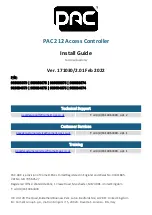
page 14
3.7 Calibration
Using a vacuum system to calibrate a gauge or gauge/tube combination will result in a more
accurate pressure measurement. For instances where this is not possible, calibrating the gauge using
a Hastings reference tube provides the best alternative.
NOTE:
For cabinet models, the top-cover must be removed to access the CAL control.
3.7.1 Calibration Using A Vacuum System
Install the gauge tube in a vacuum system (gauge connected to AC power and stabilized), then
evacuate to a pressure one decade or more below the gauge dial face resolution. Connect the gauge
to tube and wait until the displayed pressure is stable.
NOTE:
When using a DV-4 type gauge tube, system pressure must be less than 1.0 x10
-2
Torr.
When using DV-5, or DV-6 type gauge tubes, system pressure must be less than 1.0 x 10
-5
Torr.
Adjust the gauge CAL.adjustment (figure 3.2) until the meter pointer indicates zero-left on the dial
face.
3.6 Gauge Tube Operating Principle
Operation of the Hastings gauge tube is based on a low voltage AC bridge that heats a noble metal
thermopile. A change in pressure in the gauge tube changes the molecular collision rate and
therefore the thermal conduction of the gas or gas mixture surrounding the thermopile. This results
in a temperature shift in the AC heated thermocouples A and B (Fig. 3.1). The resultant temperature
shift causes a change in the DC output from couples A and B inversely with pressure changes. The
DC thermocouple C (when installed) is in series with the circuit load. Thermocouple C provides
compensation for transient changes in ambient temperature.
figure 3.1
Содержание CVT-14/24
Страница 1: ...page 1 VT CVT SERIES VACUUM GAUGES and CONTROLLERS HASTINGS INSTRUCTION MANUAL ...
Страница 4: ...page 4 ...
Страница 6: ...page 6 ...
Страница 12: ...page 12 ...
Страница 16: ...page 16 Maintainance and Repair 4 3 ...



































